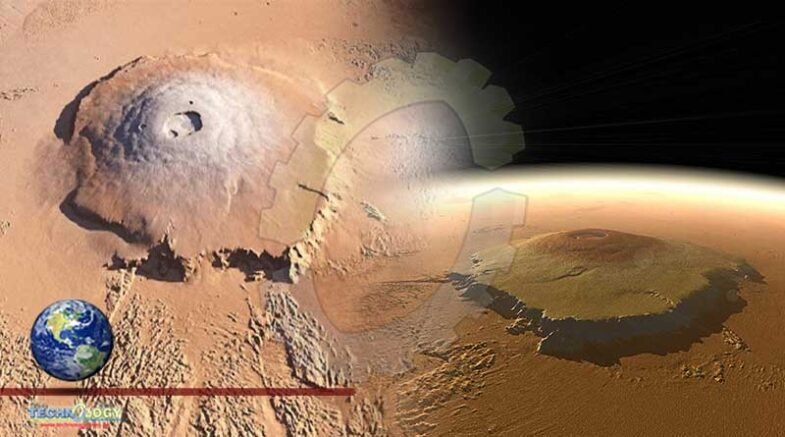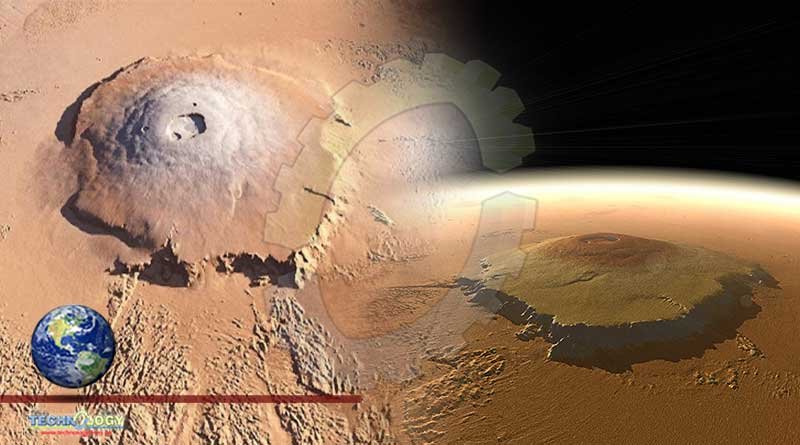Mars Olympus Mons is located on the northwestern flank of Mars. This vast volcanic field occupies about a quarter of the planet’s surface.

A few weeks ago, the first-ever Mars spacecraft from the United Arab Emirates (UAE) recorded its most spectacular photo of the largest Mars volcano: Olympus Mons.
A European spacecraft has also deciphered the mysterious long cloud that has been repeating over the planet’s Arsia Mons volcano to Olympus Mons volcano.
But one thing remains a mystery: How did Massive Olympus Mons Volcano form? Experts said the devil is indeed in the details.
Where is Mars Olympus Mons Located? How Big Is It?
This genuinely great landform mass in Mars’ western hemisphere is unrivaled in terms of absolute height and mass with almost twice the height of Mount Everest and nearly the size of the state of Arizona.
Lowell Observatory said Olympus Mons is the highest and widest peak on the planet, with a height of 72,000 feet and a distance of 374 miles.
Olympus Mons’ summit caldera is 3 km wide and spans 80 km long, according to NASA. It is 25 km high, or two and a half times the height of Mount Everest.
Olympus Mons is a shield volcano, which means it is a large and shallow volcano formed by successive outpourings of very flowing lava.
It is located on the northwestern flank of Mars’ Tharsis Rise. This vast volcanic field occupies about a quarter of the planet’s surface.
How Did Olympus Mons Form?
Paul Byrne, a planetary geologist at North Carolina State University in Raleigh, told Forbes they couldn’t explain how or when the Tharsis Raise came to be.
They do know, though, that it began to evolve at least 3 billion years ago. He went on to say that the rise is mostly made of a volcanic compound.
Jim Rice, a senior scientist at the Planetary Science Institute in Tucson, Arizona, also told Forbes that Tharsis is located over a hot spot close to the Hawaiian Islands.
However, since Mars lacks moveable crustal plates (unlike Earth), the Tharsis region’s crust remained stagnant over the hot spot. According to Rice, this is what allowed these volcanoes to rise to such massive proportions.
When massive plumes of magma rose from deep inside Mars, they remained stable relative to the surface, says Byrne, because Mars likely never had any mobile tectonic plates like Earth.
He claims that billions of years of erupted lavas and intruded magmas were able to create massive volcanic edifices while the plume and the overlying crust remained motionless relative to each other.
Francis Nimmo, a planetary scientist at the University of California, Santa Cruz, mentioned in the same Forbes article that the gravity on Mars is weaker than on Earth. As a result, the volcanoes will increase in size until the crust that supports them collapses.
What Adds to the Mysteriousness of the Place?
According to Byrne, Tharsis’s most intriguing feature is that the three so-called Tharsis Montes-Ascraeus, Pavonis, and Ascraeus Montes-are grouped in a line. According to him, there must be an ancient and deep structure in the Martian lithosphere (the planet’s porous outer layer) along which magma rose to form those volcanoes.
On the other hand, Rice wonders how the eons of eruptions in this area have changed Mars’ atmosphere. He is particularly interested in whether these eruptions altered the atmosphere enough to cause lakes and oceans to form, as well as whether they occurred at roughly the same time.
When will astronauts be able to explore the region? According to Rice, the Tharsis area isn’t big on the list of possible landing sites. And, while adventure astronaut tourism is a long way off, he believes it will happen one day.
Originally published at Science Times
